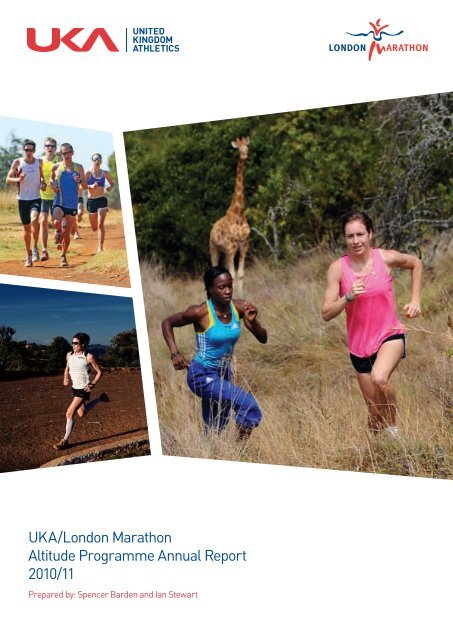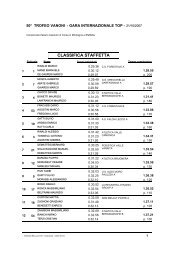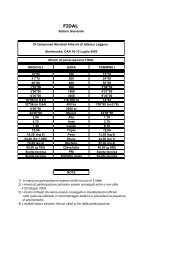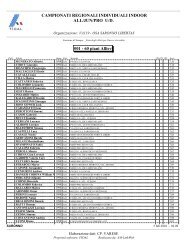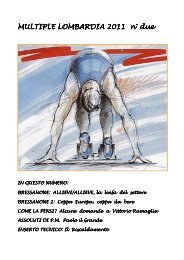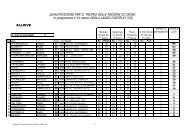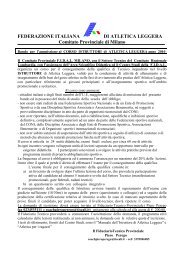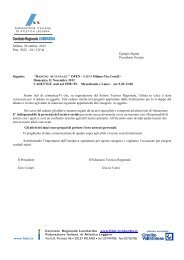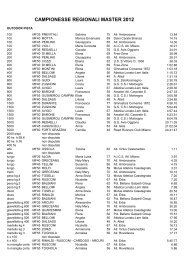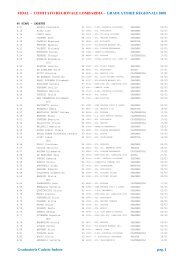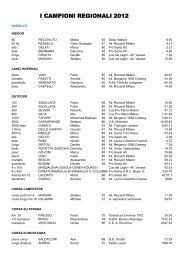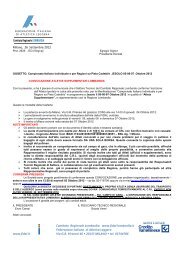UKA/London Marathon Altitude Programme ... - Fidal Lombardia
UKA/London Marathon Altitude Programme ... - Fidal Lombardia
UKA/London Marathon Altitude Programme ... - Fidal Lombardia
Create successful ePaper yourself
Turn your PDF publications into a flip-book with our unique Google optimized e-Paper software.
<strong>UKA</strong>/<strong>London</strong> <strong>Marathon</strong><br />
<strong>Altitude</strong> <strong>Programme</strong> Annual Report<br />
2010/11<br />
Prepared by: Spencer Barden and Ian Stewart
CONTENTS<br />
1. Introduction 3<br />
2. <strong>UKA</strong>/LM <strong>Altitude</strong> Model and Venues 4-5<br />
3. World Leading Sport Science and Support 6<br />
4. Font Romeu, France –Spring and Pre Barcelona Camp 7<br />
5. Iten, Kenya – Winter Camp 2010/11 8<br />
6. Case Study 9-10<br />
7. The <strong>Marathon</strong> 11<br />
8. Conclusion 12<br />
9. Appendices 12-23
1.<br />
INTrOdUCTION<br />
<strong>UKA</strong>/<strong>London</strong> MARAthon (LM) ALtItUde tRAInIng CAMP AnnUAL RePoRt | 3<br />
<strong>Altitude</strong> training - in the modern era – is used by the majority<br />
of the world’s best endurance athletes from 800m to <strong>Marathon</strong>.<br />
UK endurance athlete and coach pairings need to be exposed to the<br />
benefits of training at altitude if they are to challenge the best in<br />
the world, and this is especially true in the long endurance events.<br />
Group training at altitude is a philosophy that is a key element of<br />
the <strong>UKA</strong> Endurance Strategy.<br />
Over the past twelve months <strong>UKA</strong> and <strong>London</strong> <strong>Marathon</strong> have worked in partnership to deliver<br />
an extensive endurance altitude programme. <strong>London</strong> <strong>Marathon</strong>’s investment has enabled <strong>UKA</strong><br />
to create, for the first time ever, a centrally coordinated and supported approach to altitude<br />
training for athletes and coaches in Font Romeu, France and Iten, Kenya.<br />
The opportunity for athletes to train at altitude is promoted widely through a <strong>UKA</strong>/LM<br />
advertisement, the <strong>UKA</strong> website, England Athletics and through direct contact with<br />
athletes and coaches. The advert invites athletes and coaches to apply for a place on each<br />
of the camps. Athlete selection for each of the altitude camps involves <strong>UKA</strong> endurance<br />
staff Ian Stewart, Spencer Barden, George Gandy and John Nuttall; Mick Woods and<br />
Craig Winrow at St.Mary’s College have also been part of the identification and selection<br />
process, with approval from Dave Bedford at <strong>London</strong> <strong>Marathon</strong> on all selected athletes.<br />
The <strong>UKA</strong>/<strong>London</strong> <strong>Marathon</strong> altitude programme delivers access to altitude training for UK<br />
athletes and coaches in a managed, supported, and sustainable environment rather than<br />
resourcing athletes to fund their own camps.<br />
This is to ensure the following benefits:<br />
a) It is essential that athletes and coaches using altitude for the first time are correctly<br />
educated and prepared to ensure they maximise the benefits and avoid the potential pitfalls.<br />
b) A centrally coordinated programme enables <strong>UKA</strong> to provide appropriate and expert<br />
support personnel – pre, during and post camp;<br />
c) The <strong>UKA</strong> endurance team firmly believe that group training offers greater benefit than<br />
individual training;<br />
d) It is important to ensure that coaches as well as athletes benefit from the provision.<br />
<strong>UKA</strong> National Event Coach George Gandy is a big believer in the benefits athletes gain from<br />
training and preparing at altitude:<br />
“In my opinion the <strong>UKA</strong> and <strong>London</strong> <strong>Marathon</strong> altitude programme is the most significant<br />
advance I have seen in UK endurance running for thirty years,” he said.
2.<br />
<strong>UKA</strong>/LM ALTITUdE<br />
MOdEL ANd vENUES<br />
The <strong>UKA</strong>/LM altitude programme was almost twelve months in the planning,<br />
throughout which period a number of potential group training altitude venues<br />
were explored. <strong>Altitude</strong> training bases were initially considered through<br />
dialogue with a number of the leading UK athletes and coaches who regularly<br />
train at altitude, in addition to overseas athletes and coaches from the<br />
endurance world.<br />
Options were subsequently discussed with Exercise Physiologists Dr Barry<br />
Fudge and Professor Andy Jones, both of whom have a huge amount of<br />
experience in working with athletes at altitude.
“ Training at altitude is so<br />
important to me as an<br />
athlete – you have to train<br />
like the best in the world<br />
if you want to beat them.”<br />
Mo Farah<br />
Mo Farah has been a<br />
regular at the <strong>UKA</strong>/<br />
<strong>London</strong> <strong>Marathon</strong><br />
altitude camps in Font<br />
Romeu and Iten<br />
<strong>UKA</strong>/<strong>London</strong> MARAthon (LM) ALtItUde tRAInIng CAMP AnnUAL RePoRt | 5<br />
Fudge’s PhD focused on the environmental factors leading to<br />
the success of elite east African runners. During that time he<br />
worked with elite runners in Kenya and Ethiopia, a number of<br />
whom are World Record holders and/or World and Olympic<br />
medallists (e.g. Keninisa Bekele, Eluid Kipchoge, Felix Limo,<br />
Brimin Kipruto, Geleta Burka, Sileshi Sihine and others).<br />
Jones has been working with and advising Paula Radcliffe<br />
on her altitude strategy for the past 15 years, including<br />
conducting regular lab tests in Loughborough. More recently,<br />
he has been advising and working with Mara Yamauchi on her<br />
altitude strategy.<br />
The two altitude venues chosen by <strong>UKA</strong> and LM were Font<br />
Romeu, France and Iten, Kenya. Both are established altitude<br />
venues at 1800m (6000ft) and 2385m (8000ft) respectively.<br />
Key to the venue selection process was giving consideration to<br />
the preferred time of year to take large groups of UK athletes<br />
and coaches to altitude. These were identified as being two<br />
periods of four to five weeks; spring (April/May) and autumn/<br />
winter (Oct/Nov).<br />
In addition to the core ‘large group’ altitude camps, a rotational<br />
model of exposure to altitude with smaller groups is also<br />
integral to the altitude programme. This involves approximately<br />
three to six week blocks at high altitude and four<br />
to six week blocks at sea level, periodising the<br />
exposure to altitude to best prepare athletes<br />
and support the key domestic and international<br />
track, cross country and road events, including<br />
annual major Championships. The periodisation<br />
altitude model prolongs the time athletes spend<br />
at altitude so that the potential benefits can be<br />
maximised over a twelve month period.<br />
This is a model favoured by British athletes<br />
including Mo Farah, Chris Thompson and<br />
Paula Radcliffe.<br />
“There’s no doubt that training at altitude in Kenya and Font<br />
Romeu has made me a better athlete,” says Farah. “The<br />
support of <strong>UKA</strong> and <strong>London</strong> <strong>Marathon</strong> means I’ve had the<br />
opportunity to increase the amount of time I’ve spent in these<br />
locations, but also to increase the benefits due to the rigorous<br />
scientific support and planning. You have to train like the<br />
best in the world if you want to beat them. I’ve no doubt that it<br />
contributed to my major successes in 2010, helping me to win<br />
double gold in Barcelona.”
6 | <strong>UKA</strong>/<strong>London</strong> MARAthon (LM) ALtItUde tRAInIng CAMP AnnUAL RePoRt<br />
Number of PB’s<br />
30<br />
25<br />
20<br />
15<br />
10<br />
5<br />
0<br />
Figure 1<br />
3.<br />
WOrLd LEAdING<br />
SpOrT SCIENCE<br />
ANd SUppOrT<br />
Professor Andy Jones and Dr Barry Fudge<br />
are an essential part of the <strong>UKA</strong>/LM altitude<br />
programme team, educating and advising athletes<br />
and coaches. All athletes and coaches involved<br />
in the <strong>UKA</strong>/LM altitude training camp follow<br />
the physiological monitoring protocol set up for<br />
altitude training, which ensures athletes are<br />
best prepared prior to going to altitude, adapt to<br />
the altitude once at the venue and are reviewed<br />
when returning to sea level. The protocol set<br />
up by Jones and Fudge involves pre and post<br />
altitude laboratory/field work, and adaptation<br />
monitoring whilst at altitude. A key element within<br />
this process is blood profiling, which ensures all<br />
athletes have sufficient iron levels prior to going<br />
to altitude. As well as being part of the education<br />
process in exposing athletes and coaches to<br />
altitude training, the exercise physiologists will be<br />
able to provide specific feedback to the athletes<br />
and coaches to ensure they are maximising<br />
their time at altitude and are benefiting from the<br />
potential gains associated with responding well to<br />
altitude conditions.<br />
0.8<br />
2008<br />
*Statistically significant<br />
PB’s Progression of race times<br />
0.9<br />
*1.4<br />
2009 2010<br />
1.6<br />
1.4<br />
1.2<br />
1.0<br />
0.8<br />
0.6<br />
0.4<br />
0.2<br />
0<br />
Progression of race times from previous year (%)<br />
Data produced by Dr Barry Fudge highlights<br />
some of the progressions made in performances<br />
made by UK athletes who have been training<br />
at altitude: At the group level, there were 43<br />
personal best performances (800m to 10,000m<br />
event groups) completed by the athletes that<br />
attended the Font-Romeu camp for four weeks<br />
prior to the 2010 track season. After normalising<br />
the data (i.e. discounting athletes who did not<br />
have three years competition data and/or athletes<br />
who completed their previous personal best<br />
performances indoors) there were 24 personal<br />
best performances from 14 athletes in the 2010<br />
track season compared to just 15 in 2009 and 16<br />
in 2008 (800m to 10,000m event groups). Given<br />
that these athletes were highly trained, it may be<br />
expected that the rate of progression would be<br />
similar or gradually smaller for each subsequent<br />
year. In the present group the rate of progression<br />
in performance was 0.8%, 0.9% and 1.4% in<br />
2008, 2009 and 2010, respectively (see figure 1).<br />
Therefore this data suggests that a four week<br />
training period at altitude may be beneficial for<br />
subsequent endurance running performance,<br />
equating to about 0.5% improvement in<br />
progression of race times compared to sea level<br />
training.
4.<br />
FONT rOMEU, FrANCE -<br />
SprING CAMp 2010<br />
Nestled in the French Pyrenees, 1800m (6000ft)<br />
above sea level, Font Romeu has been a popular<br />
base in Europe for many of the world’s best<br />
endurance athletes in recent years, including Paula<br />
Radcliffe who has a permanent base there.<br />
In the spring of 2010 (mid April to mid May)<br />
<strong>UKA</strong>, with support from <strong>London</strong> <strong>Marathon</strong>, held<br />
its main altitude camp for 3-4 weeks in Font<br />
Romeu. The group consisted of World Class<br />
<strong>Programme</strong>, Futures, Aviva GB&NI Team athletes<br />
and a number of developing athletes linked to the<br />
National Performance Centre at Loughborough<br />
and Regional Centres, such as Birmingham and<br />
St.Mary’s. The Font Romeu camp catered for 28<br />
athletes and various support staff, of which details<br />
are listed here.<br />
prEpArATION CAMp<br />
prE ThE EUrOpEAN ChAMpS<br />
A group of endurance athletes used Font Romeu<br />
to prepare for the European Championships.<br />
The group consisted of Mo Farah, Chris<br />
Thompson, Jemma Simpson, Lee Merrien,<br />
Michelle Ross Cope, Helen Decker, Jo Jackson,<br />
Martin Williams and Ben Moreau.<br />
From that group, Farah won double gold in the<br />
5000m and 10000m, Thompson took 10000m silver,<br />
Merrien finished eighth and first GB & NI team<br />
member in the marathon, Ross-Cope and Decker<br />
won team bronze in the marathon and Jo Jackson<br />
finished 10th in the 20k walk; she went on to win<br />
Commonwealth Games gold in Delhi in October.<br />
The preparation camp was a huge success and<br />
a similar preparation camp will be in operation<br />
prior to the World Championships in Daegu and<br />
the <strong>London</strong> 2012 Olympics.<br />
<strong>UKA</strong>/<strong>London</strong> MARAthon (LM) ALtItUde tRAInIng CAMP AnnUAL RePoRt | 7<br />
Spring 2010:<br />
• 28 x Athletes (i.e. Mo Farah, Lisa Dobriskey and<br />
Laura Kenney)<br />
• 1 x Camp manager<br />
• 2 x Personal coaches<br />
• 3 x <strong>UKA</strong> Coaches (George Gandy, John Nuttall<br />
and Alasdair donaldson)<br />
• 3 x Physiotherapists<br />
• 2 x Exercise Physiologists<br />
• 1 x Doctor<br />
• 1 x Strength and Conditioning coach<br />
Note: not all support staff are there for a four week period,<br />
the staffing support is split across the camp<br />
The preparation camp costs prior to Barcelona<br />
were funded from the Championship budget and<br />
the <strong>Marathon</strong> team European Team Cup budget.<br />
Chris Thompson who prepared for the European<br />
Championships in Font Romeu, said:<br />
“The altitude camps have helped to me to focus<br />
solely on my running and put the edge on my<br />
fitness. I have found that my aerobic capacity has<br />
improved immensely through the camps being at<br />
altitude and this without doubt played a huge part<br />
in me gaining my silver medal in the European<br />
Championships this summer. My blood profiling<br />
has increased in ways impossible to recreate at<br />
sea level, and given me great confidence.”
8 | <strong>UKA</strong>/<strong>London</strong> MARAthon (LM) ALtItUde tRAInIng CAMP AnnUAL RePoRt<br />
5.<br />
ITEN, KENyA –<br />
AUTUMN/WINTEr<br />
2010/11<br />
Located at 2385m (8000ft) above sea level in the<br />
escarpment of the Rift Valley, the majority of the<br />
Kenyan athletes are born within a 50-mile radius of<br />
the town, whilst estimates put about 800 plus elite<br />
athletes from around the world training in Iten.<br />
The main autumn/winter camp operated in Kenya<br />
for 4-6 weeks through October-November 2010.<br />
The group consisted of World Class <strong>Programme</strong>,<br />
Futures, GB&NI Team athletes and a number<br />
of developing athletes linked to the National<br />
Performance Centre at Loughborough and Regional<br />
Centres, such as Birmingham and St.Mary’s and<br />
other talented athletes around the UK.<br />
Autumn/Winter 2010:<br />
• 26 x Athletes (i.e. Mo Farah, Marilyn Okoro,<br />
helen Clitheroe, Charlene Thomas, Kate Avery,<br />
James Brewer, Andrew Osagie, and<br />
Colin McCourt)<br />
• 1 x Camp manager<br />
• 5 x Personal coaches<br />
• 3 x <strong>UKA</strong> Coaches (George Gandy, John Nuttall<br />
and Alasdair donaldson)<br />
• 3 x Physiotherapists<br />
• 2 x Exercise Physiologists<br />
• 1 x Doctor<br />
• 1 x Soft Tissue Therapist<br />
Note: not all support staff are there for a four week period,<br />
the staffing support is split across the camp.<br />
Winter (Jan – April) 2011:<br />
Continuing on from a successful altitude camp pre<br />
Christmas in Iten, there was considerable interest<br />
in the January camp, much more than initially<br />
anticipated. This was in part due to the positive<br />
feedback and key performance indicators shown<br />
by athletes who had previously attended the camps<br />
and our ability to fund more places with <strong>London</strong><br />
<strong>Marathon</strong> funding.<br />
Details are below of the Jan – April camp, detailing<br />
the breakdown of camp personnel and some of the<br />
key athletes.<br />
24 x Athletes (i.e. Hannah England, Marilyn<br />
Okoro, Lee Merrien, Charlene Thomas, helen<br />
Clitheroe, James Brewer, Andrew Osagie, Ben<br />
Whitby, Andy Baddeley and Colin McCourt)<br />
• 1 x Camp manager<br />
• 6 x Personal coaches<br />
• 2 x <strong>UKA</strong> Coaches (George Gandy, John Nuttall)<br />
• 3 x Physiotherapists<br />
• 1 x Exercise Physiologists<br />
• 1 x Soft Tissue Therapist<br />
Helen Clitheroe in particular returned to the UK<br />
in outstanding form and almost immediately<br />
reduced her 3000m best to 8:39.81 to go sub-<br />
8:40 for the first time. She went to the European<br />
Indoor Championships ranked number one on the<br />
continent and didn’t disappoint, racing to gold and<br />
her first ever major Championship medal.<br />
A number of athletes on the camp sent emails<br />
containing positive feedback (see appendices).
6.<br />
CASE STUdy:<br />
hELEN CLIThErOE,<br />
IMpACT OF ALTITUdE TrAINING<br />
ON hEr phySIOLOGICAL prOFILE.<br />
Some of the physiological factors<br />
that are known to be related to<br />
endurance running performance<br />
include: maximal O2 uptake (VO2max),<br />
running economy, and the fractional<br />
utilisation of the VO2max (which is<br />
itself related to markers of blood<br />
lactate accumulation during exercise,<br />
including the lactate threshold<br />
(LT) and lactate turn-point (LTP).<br />
Physiological laboratory testing<br />
measures these factors and repeated<br />
testing provides information on<br />
progression of these key markers<br />
as well assessment of recent<br />
training prescription (including the<br />
impact of training practices such<br />
as altitude training). This brief case<br />
study of Helen Clitheroe is to provide<br />
a specific example of the impact<br />
altitude training can have on the<br />
physiology of an athlete with particular<br />
reference to racing performance.<br />
<strong>Altitude</strong> training<br />
From a physiological perspective<br />
the main benefit of altitude training<br />
is to increase the number of red<br />
blood cells (haemoglobin mass).<br />
Red blood cells are the vehicle by<br />
which oxygen is delivered round<br />
the body to the working muscles; in<br />
general terms the more red blood<br />
cells the greater the aerobic work<br />
capacity. For example an increase in<br />
haemoglobin concentration of 0.3 g/<br />
dL will theoretically result in a 1%<br />
improvement in VO2max. There are<br />
also other physiological benefits<br />
from living and/or exercising in a low<br />
oxygen environment. For example<br />
altitude training can generally<br />
enhance many other key aerobic<br />
elements such as increased capillary<br />
number and length, increased<br />
number of mitochondria, improved<br />
blood lactate removal and improved<br />
muscle buffer capacity to name a few.<br />
physiology of helen Clitheroe<br />
Helen has had physiological testing<br />
completed for a number of years<br />
that consists of a warm up of 10 min<br />
followed by a multi-stage incremental<br />
treadmill protocol, typically involving<br />
5-7 exercise stages, each of 3 min<br />
duration. The test is designed to<br />
monitor progression in key variables<br />
(see above) and also to generate<br />
Blood (La) (mM)<br />
10<br />
8<br />
6<br />
4<br />
2<br />
0<br />
Table 1: Key physiological markers over a series of tests.<br />
<strong>UKA</strong>/<strong>London</strong> MARAthon (LM) ALtItUde tRAInIng CAMP AnnUAL RePoRt | 9<br />
accurate training zones by measuring<br />
blood lactate concentration, heart<br />
rate and oxygen uptake throughout<br />
the test. Shifting the LT and/or LTP<br />
to a higher speed is an important<br />
goal of endurance training. The<br />
lactate concentration at any speed<br />
should be lower (downward shift in<br />
the lactate curve) and the LT and<br />
LTP should occur at higher speeds<br />
(rightward shift in the lactate<br />
curve) with endurance training. In<br />
addition, HR should be lower for a<br />
given speed (downward shift in HR<br />
curve). Figure 2 and Table 1 detail<br />
(La)-Mar 11 (La)-Dec 10 (La)-Jan 08 (La)-Mar 07<br />
HR-Mar 11 HR-Dec 10 HR-Jan 08 HR-Mar 07<br />
13 14 15 16 17<br />
Speed (km/h)<br />
18 19 20 21<br />
Figure 2: Aerobic profile over a series of tests.<br />
Test: 1 2 3 4<br />
date: Mar-11 dec-10 Jan-08 Mar-07<br />
Body mass (kg): 57.4 58.4 59.0 58.9<br />
LT (km/h): 17.0 16.5 16.0 16.0<br />
LTP (km/h): 19.0 18.5 18.0 18.0<br />
Economy (mL O2/kg/km): 214 207 199 199<br />
VO2max (mL/kg/min): 76 73 70 66<br />
200<br />
150<br />
100<br />
50<br />
0<br />
Heart Rate (beats/min)
10 | <strong>UKA</strong>/<strong>London</strong> MARAthon (LM) ALtItUde tRAInIng CAMP AnnUAL RePoRt<br />
CASE STUdy CONTINUEd<br />
Helen’s aerobic profile over a series<br />
of four tests. It can be seen that there<br />
has been a dramatic shift in her<br />
aerobic profile between December<br />
2010 and March 2011 with some<br />
changes evident in December 2010<br />
compared to previous tests. For<br />
an athlete of Helen’s calibre and<br />
running experience such changes<br />
are extremely difficult to achieve and<br />
are usually the result of year on year<br />
progression rather than a dramatic<br />
shift. This may to a large degree be<br />
explained by a number of repeated<br />
altitude exposures. Prior to the<br />
December 2010 test Helen undertook<br />
a four week period of training in<br />
Iten, Kenya (2450m above sea level)<br />
and prior to the March 2011 test<br />
she undertook a further four week<br />
training block in Kenya.<br />
Table 2 details predicted racing<br />
potential based on known fixed<br />
physiological values. It is clear that<br />
the physiological changes evident<br />
after repeated altitude trips (Table<br />
1 and Figure 2) have the potential to<br />
influence racing performance over<br />
a wide number of events significantly.<br />
Test Mar-11 Dec-10 Jan-08 Mar-07 Prediction<br />
3000m 08:27.86 08:30.41 08:31.71 09:02.73 100% vVo2max<br />
5000m 14:50.98 14:55.46 14:57.74 15:52.15 97% vVo2max<br />
10000m 31:34.74 32:25.95 33:20.00 33:20.00 Using LtP<br />
<strong>Marathon</strong> 2:28:55 2:32:43 2:37:30 2:37:30 Using Lt<br />
Table 2: predicted racing potential. vVO2max = velocity at VO2max<br />
Summary<br />
• <strong>Altitude</strong> training can enhance key<br />
physiological markers greater than<br />
expected from sea level training<br />
alone.<br />
• Repeat altitude exposures likely<br />
have an additive effect resulting in<br />
larger gains than one trip alone.<br />
• The gains (as evidenced by key<br />
physiological markers) have the<br />
potential to significantly improve<br />
racing performance over a wide<br />
range of events.
7.<br />
ThE MArAThON<br />
A number of athletes who took part in the 2011 Virgin<br />
<strong>London</strong> <strong>Marathon</strong> had spent periods at the <strong>UKA</strong>/<strong>London</strong><br />
<strong>Marathon</strong> <strong>Altitude</strong> Training Camp in Kenya, including Lee<br />
Merrien who was the first British athlete to finish in 14th<br />
in a lifetime best of 2:14:27.<br />
Merrien – who finished eighth in the 2010 European<br />
Championships marathon in Barcelona following a period<br />
of training at the <strong>UKA</strong>/LM camp in Font Romeu, France -<br />
has spent over two months training in Kenya this winter<br />
(2010/11), and following his recent selection for the IAAF<br />
World Championships <strong>Marathon</strong> in Daegu this summer,<br />
will return to the <strong>UKA</strong>/LM spring/summer camp in Font<br />
Romeu prior to the event.<br />
In addition to Merrien, Helen Decker, team bronze<br />
medallist in the European Championships marathon in<br />
July 2010 and also a beneficiary of the spring/summer<br />
Font Romeu camp, finished 27th in the Virgin <strong>London</strong><br />
<strong>Marathon</strong> in 2:35:43.<br />
Linked to the marathon specifically, Decker – as<br />
evidenced in the following charts - is proven to have a<br />
significant increase in fat oxidation following a period of<br />
training at altitude in Kenya which is a key determinant of<br />
performance; to get round the marathon an elite athlete<br />
needs around 5-6kcal/min at marathon pace from fat<br />
oxidation, anything less and they will likely hit the wall<br />
and/or run a lot slower than they should.<br />
In addition, the data produced by Dr Barry Fudge<br />
(section 3) identified the potential 0.5% improvement in<br />
performance for endurance events (800m – 10,000m),<br />
which is significant for athletes preparing or moving<br />
towards the <strong>Marathon</strong> or currently preparing for the event<br />
over the shorter distances.<br />
The altitude strategy that has been developed through the<br />
support from <strong>London</strong> <strong>Marathon</strong> will continue to ensure<br />
that key <strong>Marathon</strong> athletes are given the opportunity to<br />
train at altitude. They can prepare for the Virgin <strong>London</strong><br />
<strong>Marathon</strong> during the January to April period, and look<br />
to achieve qualifying times for the forthcoming major<br />
Championship <strong>Marathon</strong>.<br />
<strong>Marathon</strong> athletes selected for the World Championships<br />
in Daegu and the <strong>London</strong> Olympics will all have<br />
the opportunity to train in Font Romeu prior to the<br />
Championships, thus ensuring the <strong>Marathon</strong> athletes are<br />
best prepared.<br />
30.00<br />
25.00<br />
20.00<br />
15.00<br />
10.00<br />
5.00<br />
0.00<br />
30.00<br />
25.00<br />
20.00<br />
15.00<br />
10.00<br />
5.00<br />
0.00<br />
<strong>UKA</strong>/<strong>London</strong> MARAthon (LM) ALtItUde tRAInIng CAMP AnnUAL RePoRt | 11<br />
CHO (kcal/min)<br />
14 15 16 17 18 19<br />
pre altitude fat oxidation<br />
CHO (kcal/min)<br />
Fat (kcal/min)<br />
Fat (kcal/min)<br />
ChO/Fat<br />
ChO/Fat<br />
15 16 17 18 19 20<br />
post altitude changes in fat oxidation
12 | <strong>UKA</strong>/<strong>London</strong> MARAthon (LM) ALtItUde tRAInIng CAMP AnnUAL RePoRt<br />
8.<br />
CONCLUSION<br />
The altitude camps have been well<br />
supported to date and going forward, a<br />
stronger focus will be put on ensuring<br />
that our key endurance athletes maximise<br />
the opportunity to train at altitude as we<br />
move towards 2012 and beyond. Already<br />
the interest for future camps has been<br />
extremely positive, and word on how good<br />
the camps are is spreading back to the UK<br />
from those who have been to Font Romeu<br />
and Iten. The important factor is that over<br />
the past 12 – 18 months the investment into<br />
the altitude programme, not just in pounds,<br />
but in man-hours in terms of organisation<br />
and camp management/support, is actually<br />
having a positive and progressive impact on<br />
athlete performances.<br />
The January 2011 camp in Kenya was the<br />
most successful to date with a selection<br />
of the UK’s best endurance athletes in<br />
attendance. This highlights that key athletes,<br />
some of whom are serious Championship<br />
9.<br />
AppENdICES<br />
From Steve Shaw, coach to Ricky Stevenson<br />
Sent: 28 February 2011 21:04<br />
To: Spencer Barden<br />
Subject: Re: Kenya<br />
Hello Spencer.<br />
Again, a big thank you to you and UK Athletics<br />
for sending Rick and I on the most inspiring<br />
experience in Kenya, It’s a trip we will never<br />
forget. The vision I have as a coach is simple,<br />
from what I’ve seen in Kenya, the more trips to<br />
Kenya the better, working in groups or with the<br />
Kenyan’s at certain times is the key to future<br />
success, if we don’t we might as well give in,<br />
a sad thing to say but that’s just how I saw it.<br />
Ricky and I learned so much out there, so<br />
thank you again.<br />
medal contenders, are now using altitude to<br />
enhance their performance.<br />
The online survey feedback through online<br />
survey tool ‘survey monkey’ has provided<br />
some useful information from athletes and<br />
coaches to help fine tune the athlete camps<br />
to make then event better. For example,<br />
<strong>UKA</strong> will look to support future altitude<br />
camps in Kenya with a <strong>UKA</strong> nutritionist, in<br />
addition to purchasing mountain bikes to<br />
help the coaches and relevant support staff<br />
to accompany athletes on training runs.<br />
Going forward, as the altitude programme<br />
continues to expand, consideration should<br />
be given to acquiring land/property in<br />
Kenya and Font Romeu. Given the altitude<br />
programme is a long term project it will<br />
probably be more cost effective to own a<br />
property/base at altitude.<br />
From Emma Pallant<br />
Sent: 03 February 2011 10:14<br />
To: Ian Stewart; Spencer Barden<br />
Subject: Thank you<br />
Dear Ian, Spencer and Dave,<br />
I just wanted to write to you all to say thank you so much for the<br />
past three weeks altitude training in Kenya. I arrived back in the<br />
early hours of this morning and I am missing it already. I have never<br />
before had the opportunity to dedicate three weeks to the one thing<br />
that I love doing, running. This wouldn’t have been possible without<br />
the superb choice of venue, generous sponsor of <strong>London</strong> <strong>Marathon</strong><br />
and fantastic organisation by <strong>UKA</strong> endurance. I know that if you<br />
want to be the best there is no easy path to get there and I love<br />
working hard for it but guys like you, putting on camps like these<br />
help to clear that path so that we can then work even harder. I felt<br />
that all my needs were provided for, from the basics such as good<br />
food and drink to the training essentials such as the presence of my<br />
coach, Mick. I am extremely grateful for the hard work you are all<br />
putting into our sport and in particular my personal development.<br />
Many Thanks<br />
Emma Emma Pallant Pallant
ALTITUDE<br />
TRAINING<br />
OPPORTUNITIES<br />
<strong>UKA</strong> and <strong>London</strong> <strong>Marathon</strong> are pleased to announce the 2011<br />
and early 2012 altitude training camp programme for UK<br />
endurance athletes.<br />
Following the successful implementation of the <strong>UKA</strong>/<strong>London</strong> <strong>Marathon</strong><br />
altitude programme throughout 2010, the key objective for the altitude<br />
strategy going forward is to continue to provide athletes and coaches<br />
with the opportunity to train in a group environment within a managed<br />
and supported programme in Font Romeu (France) and Iten (Kenya)<br />
at heights of 1850m and 2350m above sea level respectively.<br />
The main camps will be supported by a team of <strong>UKA</strong> support staff<br />
including coaches, physiotherapists, doctors, soft tissue therapists<br />
and exercise physiologists.<br />
The <strong>UKA</strong>/<strong>London</strong> <strong>Marathon</strong> altitude programme has already had a<br />
positive impact with a number of successful performances throughout the<br />
2010 summer season including Mo Farah’s double European<br />
Championships gold over 5,000m and 10,000m and Chris Thompson’s<br />
European Championships silver at 10,000m following periods of altitude<br />
training in Iten and Font Romeu. Jo Jackson – who finalised her<br />
preparations for the European Championships 20km Walk in Font Romeu<br />
and finished tenth – went on to win Commonwealth Games gold in Delhi.<br />
The positive feedback surrounding the altitude programme and the<br />
continued forward momentum in UK endurance running has meant<br />
that the altitude camps are now becoming increasing popular,<br />
especially amongst some of the UK’s leading endurance athletes.<br />
Description<br />
(2011/early 2012 altitude camps)<br />
Spring Training Camp<br />
Summer Training Camp and<br />
Preparation Camp pre World<br />
Champs (Daegu)<br />
Winter Training Camp<br />
Training Camp – Indoor/Cross<br />
Country/Road Race Season<br />
If you have any questions on the above please contact:<br />
<strong>UKA</strong> National Endurance Senior Coordinator - Spencer Barden<br />
by email sbarden@uka.org.uk<br />
<strong>UKA</strong>/<strong>London</strong> MARAthon (LM) ALtItUde tRAInIng CAMP AnnUAL RePoRt | 13<br />
Closing date for<br />
Departure and return dates Location<br />
expression of interest @<strong>Altitude</strong><br />
Depart: 11 or 18 April 2011<br />
Return: 2 May or 13 May 2011<br />
Font Romeu, France 31 January 2011 3-4 weeks<br />
(option to stay longer for WCPP or Futures funded athletes)<br />
Depart: 21 June – Agreed return dates -<br />
UK Champs/Trials/various DL meets/World Champs<br />
Depart: 23 July – Agreed return dates for World Champs -<br />
Primarily <strong>Marathon</strong> athletes selected for Daegu<br />
Depart: 1 August – Agreed return dates for World Champs<br />
Depart: 27 October or 10 November 2011<br />
Return: 24 November or 8 December 2011<br />
The camps are open to all UK endurance athlete and coach pairings,<br />
however, the availability for places funded by <strong>UKA</strong>/<strong>London</strong> <strong>Marathon</strong><br />
for 2011 will be prioritised from the list below. If availability allows at<br />
each venue, athletes and coaches are welcome to attend the camps<br />
on a self funded basis.<br />
<strong>UKA</strong>/<strong>London</strong> <strong>Marathon</strong> funded places will be prioritised as follows:<br />
1. World Class Performance <strong>Programme</strong> (WCPP) athletes<br />
2. <strong>UKA</strong> ‘Futures’ <strong>Programme</strong> athletes<br />
3. Current GB&NI team athletes (GB&NI representation in the<br />
12 months prior to the start of each camp)<br />
4. <strong>UKA</strong> and <strong>London</strong> <strong>Marathon</strong> nominated athletes and coaches<br />
5. Home Country Federation nominated coaches<br />
(linked to coach development initiatives through the<br />
National Coach Mentor programme)<br />
The <strong>UKA</strong>/<strong>London</strong> <strong>Marathon</strong> altitude camp programme is detailed<br />
below. Any UK endurance athletes who fulfil the above criteria and<br />
are interested in attending any future altitude training camps should<br />
in the first instance express their interest before the relevant closing<br />
dates with <strong>UKA</strong> National Endurance Senior Coordinator Spencer<br />
Barden by email sbarden@uka.org.uk with details of the camp they<br />
would like to attend.<br />
Font Romeu, France N/A 3-6 weeks<br />
Iten, Kenya 31 August 2011 3-5 weeks<br />
January to April 2012 (exact dates TBC) Iten, Kenya 1 November 2011 3-6 weeks<br />
Spring Training Camp Mid April to Mid May 2012 (exact dates TBC) France TBC 3-4 weeks<br />
George Gandy (National Event Coach – Endurance), Ian Stewart (Head of Endurance), Spencer Barden (National Endurance Senior Coordinator) and<br />
David Bedford (Race Director <strong>London</strong> <strong>Marathon</strong>) will make the final decision on who will be offered the available places on each of the altitude camps.
14 | <strong>UKA</strong>/<strong>London</strong> MARAthon (LM) ALtItUde tRAInIng CAMP AnnUAL RePoRt<br />
Printed for Jason.Henderson@athletics-weekly.com from Athletics Weekly (10 February 2011) at www.exacteditions.com. Copyright © 2011.
<strong>UKA</strong>/<strong>London</strong> MARAthon (LM) ALtItUde tRAInIng CAMP AnnUAL RePoRt | 15<br />
Printed for Jason.Henderson@athletics-weekly.com from Athletics Weekly (10 February 2011) at www.exacteditions.com. Copyright © 2011.
16 | <strong>UKA</strong>/<strong>London</strong> MARAthon (LM) ALtItUde tRAInIng CAMP AnnUAL RePoRt<br />
Printed for Jason.Henderson@athletics-weekly.com from Athletics Weekly (10 February 2011) at www.exacteditions.com. Copyright © 2011.
<strong>UKA</strong>/<strong>London</strong> MARAthon (LM) ALtItUde tRAInIng CAMP AnnUAL RePoRt | 17<br />
Printed for Jason.Henderson@athletics-weekly.com from Athletics Weekly (10 February 2011) at www.exacteditions.com. Copyright © 2011.
18 | <strong>UKA</strong>/<strong>London</strong> MARAthon (LM) ALtItUde tRAInIng CAMP AnnUAL RePoRt<br />
Printed for Jason.Henderson@athletics-weekly.com from Athletics Weekly (10 February 2011) at www.exacteditions.com. Copyright © 2011.
<strong>UKA</strong>/<strong>London</strong> MARAthon (LM) ALtItUde tRAInIng CAMP AnnUAL RePoRt | 19<br />
Printed for Jason.Henderson@athletics-weekly.com from Athletics Weekly (10 February 2011) at www.exacteditions.com. Copyright © 2011.
20 | <strong>UKA</strong>/<strong>London</strong> MARAthon (LM) ALtItUde tRAInIng CAMP AnnUAL RePoRt<br />
running Fitness, May 2011<br />
Last month, we revealed the secrets<br />
of Lornah Kiplagat’s High <strong>Altitude</strong><br />
Training Centre (HATC) in Iten, Kenya.<br />
Here we catch up with one of Britain’s<br />
top marathon runners, Lee Merrien,<br />
to find out how he, and some of<br />
our leading endurance athletes,<br />
are benefiting from a <strong>UKA</strong>/<strong>London</strong><br />
<strong>Marathon</strong> altitude programme to<br />
help make their 2011 seasons – and<br />
beyond – as successful as possible<br />
“YOU CAN’T FAIL TO BE INSPIRED BY<br />
ITEN: THE WEATHER’S GREAT, IT’S<br />
AT HIGH ALTITUDE AND THERE ARE<br />
LOTS OF BEAUTIFUL PLACES TO RUN.<br />
IT LITERALLY TICKS EVERY BOX.”<br />
So says Lee Merrien, Britain’s top finisher in last year’s European<br />
Championships marathon. He was one of 17 British international<br />
athletes who attended a recent <strong>UKA</strong>/<strong>London</strong> <strong>Marathon</strong> altitude<br />
training camp at the Lornah Kiplagat High <strong>Altitude</strong> Training Centre.<br />
The delivery of the training camp built on the successful<br />
implementation of the overall <strong>UKA</strong>/LM altitude programme in 2010<br />
and offered another focused training opportunity for athletes
BRITAIN'S TOP MIDDLE AND<br />
LONG DISTANCE RUNNERS<br />
ARE HOPING TO BENEFIT<br />
FROM THE ALTITUDE<br />
TRAINING PROGRAMME<br />
and coaches in a group environment, a key objective of <strong>UKA</strong>’s<br />
endurance strategy.<br />
As revealed last month, Iten, situated in the famous Rift Valley<br />
Province, is the training base for hundreds of athletes including<br />
2009 world champions Florence Kiplagat, Mary Keitany, Linet Masai<br />
and Vivian Cheruiyot, and while it’s referenced as the “capital of<br />
running” in Kenya, it is arguably the epicentre of the endurance<br />
world , with a reputation that keeps growing.<br />
Based on the firm belief that group training offers greater<br />
benefits than individual training, <strong>UKA</strong>’s endurance team wanted<br />
to deliver a programme with provision of appropriate and expert<br />
support personnel pre-camp, during and post-camp to ensure that<br />
athletes and coaches, many of whom would be exposed to altitude<br />
for the first time, were correctly educated and prepared.<br />
The resultant <strong>UKA</strong>/LM altitude programme was almost 12 months<br />
<strong>UKA</strong>/<strong>London</strong> MARAthon (LM) ALtItUde tRAInIng CAMP AnnUAL RePoRt | 21<br />
in the planning, and following detailed and evidence-based input<br />
from exercise physiologists Dr Barry Fudge and Professor Andy<br />
Jones - both of whom have a huge amount of experience in working<br />
with athletes at altitude - in addition to consultation with leading<br />
domestic and overseas endurance athletes and coaches, the two<br />
altitude venues ultimately chosen by <strong>UKA</strong> and LM were Font Romeu<br />
in France and Iten in Kenya, at heights of 1800m (6000ft) and<br />
2385m (8000ft) respectively.<br />
WATCHFUL EYES<br />
Sports science and educational support, primarily delivered by<br />
Fudge and Jones, is integral to the <strong>UKA</strong>/LM altitude programme.<br />
Athletes follow the physiological monitoring protocol set up for<br />
altitude training which ensures they’re best prepared prior to going<br />
to altitude, adapt to the altitude once at the venue and are then
22 | <strong>UKA</strong>/<strong>London</strong> MARAthon (LM) ALtItUde tRAInIng CAMP AnnUAL RePoRt<br />
82 ENDURANCE<br />
reviewed when they return to sea level.<br />
The protocol involves pre and post-altitude<br />
laboratory/field work and adaptation<br />
monitoring whilst at altitude.<br />
As well as being part of the educational<br />
process in exposing athletes and coaches to<br />
altitude training, the exercise physiologists<br />
are able to provide specific feedback to<br />
both to ensure they are maximising their<br />
time at altitude and are benefiting from the<br />
potential gains associated with responding<br />
well to altitude conditions.<br />
The <strong>UKA</strong>/LM altitude programme has<br />
already had a positive impact with a number<br />
of encouraging performances throughout<br />
the 2010 summer season. These included<br />
Mo Farah’s double European Championships<br />
gold over 5,000m and 10,000m and Chris<br />
Thompson’s European Championships silver<br />
at 10,000m both won following periods of<br />
altitude training in Iten and Font Romeu<br />
in the Catalan Pyrenees. Jo Jackson – who<br />
finalised her preparations for the European<br />
Championships 20km walk in Font Romeu<br />
and finished tenth – went on to win<br />
Commonwealth Games gold in Delhi.<br />
Athletes who attended the first camp<br />
of the year in Kenya in 2011 are already<br />
excelling, including Helen Clitheroe who<br />
recorded a European leading time of<br />
8:39.81 in the 3000m when finishing<br />
fourth in a world class field in the Aviva<br />
Grand Prix in February. Helen also held on<br />
to a thrilling victory in the recent European<br />
Indoor Championships.<br />
<strong>UKA</strong>’s Head of Endurance, Ian Stewart,<br />
says it’s the whole package and not just<br />
the altitude that gives athletes the edge:<br />
“The majority of the world’s best endurance<br />
athletes are based at altitude and we have<br />
a strong evidence base to prove why it<br />
works,” he says. “Thanks to <strong>UKA</strong> and with<br />
the support of <strong>London</strong> <strong>Marathon</strong> we’re now<br />
able to offer our athletes and their coaches<br />
access to altitude training for almost 12<br />
months of the year for the first time.<br />
“Training together in a group environment<br />
is a key aspect of our endurance strategy,<br />
but the fact that both Font Romeu and Iten<br />
are such inspirational places and full of likeminded<br />
people is just as important as the<br />
fact that we’re based at altitude.<br />
Above<br />
right: Helen<br />
Clitheroe<br />
training on<br />
the track<br />
near Iten<br />
Left:<br />
Lee Merrien<br />
Below<br />
right: Nick<br />
McCormick<br />
and Steph<br />
Twell<br />
training<br />
under the<br />
watchful<br />
eyes of UK<br />
coach Mick<br />
Woods<br />
Below<br />
left: Nick<br />
McCormick<br />
meets<br />
some of<br />
the local<br />
wildlife
“We’re offering a fully managed and supported programme with<br />
medical, physiological and nutritional assistance and we’re giving<br />
our athletes the opportunity to benefit from an exceptional training<br />
environment surrounded by world class athletes.<br />
“It doesn’t have to be fancy – the great thing about Kenya, for<br />
example, are the miles and miles of dirt trails; there’s literally<br />
nothing else to do up there but train, which is exactly what they<br />
need to maintain their focus.”<br />
The training environment in Iten – as well as in Font Romeu - is<br />
unprecedented for endurance athletes.<br />
“I loved the experience of Iten,” says Lee Merrien. “It’s a fantastic<br />
environment in all aspects of running life. I had a little bit of an<br />
idea what to expect as friends had been out there already, but I<br />
really liked it – and will be going back to put the finishing touches<br />
to my VLM preparations.”<br />
In addition to the two core camps which run for four to five<br />
weeks in spring (April/May) and autumn/winter (Oct/Nov), smaller<br />
dedicated camps of three to four weeks, as well as Aviva holding/<br />
preparation camps for athletes selected for the annual major<br />
championships will be operational going forward.<br />
This enables a rotational model of exposure to altitude which<br />
is central to the success of the altitude programme and involves<br />
approximately three to six week blocks at high altitude and four<br />
to six week blocks at sea level; this periodisation altitude model<br />
prolongs the time athletes spend at altitude so that the potential<br />
benefits can be maximised over a twelve month period. RF<br />
<strong>UKA</strong>/<strong>London</strong> MARAthon (LM) ALtItUde tRAInIng CAMP AnnUAL RePoRt | 23<br />
83<br />
LEE MERRIEN<br />
DISCUSSES HIS<br />
ITEN EXPERIENCE<br />
“Generally, I will use a<br />
training camp in the buildup<br />
to an important race.<br />
This year, for example, I’ve<br />
used a couple of camps in<br />
preparation for the Virgin<br />
<strong>London</strong> <strong>Marathon</strong> and last<br />
year I used Font Romeu<br />
before the Commonwealth<br />
Games and the European<br />
Championships. The main<br />
benefit for me is that you<br />
can focus purely on training<br />
and get the rest you need –<br />
without any distractions. It<br />
means you can eat and sleep<br />
like an athlete, perhaps better<br />
than you can in your own<br />
home environment.<br />
“Most days, we’d run as a<br />
group at 7am, although we<br />
also had the opportunity to<br />
run with the Kenyans, and<br />
their runs would start at<br />
6.15am.We would join the<br />
Kenyans on what were their<br />
‘easy easy’ runs. These would<br />
be about 70-80 minutes and<br />
at an average of no faster than<br />
6.30 min/miling, but bearing<br />
in mind the first mile is run at<br />
9 minutes, it gives you an idea<br />
of how much it picks up. It’s a<br />
fantastic time to run as the sun<br />
comes up.We’d run in almost<br />
complete silence: the Kenyans<br />
are incredibly focused.”<br />
As you might expect, with<br />
everything concentrated on<br />
running, the distractions of<br />
everyday life are few and far<br />
between.“We all got very<br />
good at table tennis,” says Lee.<br />
“We did have Internet access,<br />
but the connection wasn’t<br />
great. And we played a lot of<br />
board games – something I<br />
hadn't done for ages.You’re<br />
happy to be relaxing and<br />
doing things like having an<br />
afternoon nap: you just tend<br />
to fall into the Kenyan way of<br />
life, which generally means<br />
that everything’s done at its<br />
own pace.”<br />
A second training session<br />
would then take place later<br />
in the day. Steady runs would<br />
head out at about 5pm, or, if it<br />
had been an interval session<br />
mid-morning, then the second<br />
run would be about half an<br />
hour later.“We’d run twice a<br />
day, every day, and we’d also<br />
do weights,” says Lee.“I was<br />
averaging around 120 miles a<br />
week, but with the altitude, it<br />
be would be worth a bit more<br />
in the UK.”<br />
And how has it helped<br />
his preparation? “If<br />
everything goes well, I’d be<br />
looking at trying to get some<br />
qualifying times at <strong>London</strong> for<br />
the World Championships,”<br />
says Lee.“Training is going<br />
well: if I don’t run faster than<br />
last year, than something<br />
will have gone wrong. I was<br />
actually in shape at last year's<br />
European Championships in<br />
Barcelona to run quicker than<br />
I did at <strong>London</strong>, so if I can<br />
push on again from that, I will<br />
get the times I need.”<br />
For more information on the <strong>UKA</strong>/<br />
LM <strong>Altitude</strong> Training Camps please<br />
contact <strong>UKA</strong> National Endurance<br />
Senior Co-ordinator Spencer Barden:<br />
sbarden@uka.org.uk
All photos courtesy of Mark Shearman


